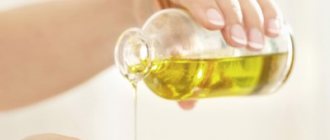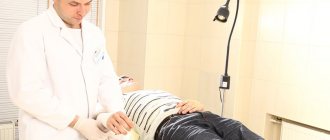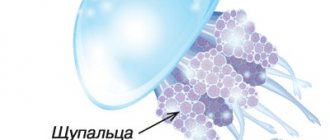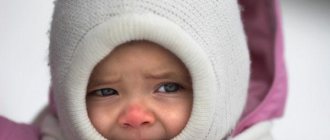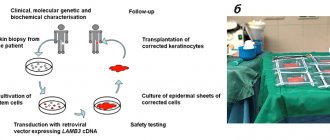This article is for informational purposes only. Our specialists do not provide medical advice. Contact your healthcare provider.
Chemical skin burns are not as common as thermal burns, but everyone has the risk of getting such damage, even in everyday life. A common pipe cleaner, vinegar essence, potassium permanganate, some medications - all this, if handled carelessly, can cause a serious chemical burn to the skin.
Each substance causes a specific type of burn:
- Organic and inorganic acids. In a small amount, they form an extensive, but not the deepest, wound, since due to the effects of the acid, the skin proteins coagulate, forming a scab that prevents further penetration of liquid. But the degree of burn depends on the amount of acid.
- Alkalis. They completely dissolve organic matter, so even a small amount of alkali is enough to cause a deep skin burn that is difficult to treat.
- Metals, salts. These include potassium permanganate, phosphorus, and mercury. In addition to severe chemical burns, they cause poisoning of the body.
- Gases. These include mustard gas, vapors of concentrated acids or alkalis, gasoline, and methyl bromide. Causes burns to both skin and mucous membranes.
- Metrogyl, Zinerit, Baziron, ointments and creams with mustard powder, red pepper are topical medications. Causes minor burns in case of overdose.
Classification by degree
The choice of treatment for chemical burns depends not only on the substance that caused the injury, but also on the degree of damage. The degree of burn is determined by the depth of the wound, there are 4 of them:
- The first is the mildest degree of chemical burn, in which only the surface layer is destroyed. No treatment is required, recovery occurs within a few days.
- In the second degree, the deep layers of the dermis are destroyed, but the basal layer is not affected, which makes it possible for tissue regeneration. Medical care involves the use of drugs that accelerate healing and prevent wound infection.
- The third degree is more serious - the basal layer of the dermis is damaged, so conservative treatment methods for chemical burns of this type are ineffective.
- The most serious, severe degree - tissues of the skin, subcutaneous fat, and muscles are destroyed. Help for chemical burns in such cases is not always effective in terms of tissue restoration.
Precautions and prevention measures
To protect yourself from chemical burns, you should follow simple rules.
When working with aggressive substances, you must wear personal protective equipment, such as gloves, goggles and a respirator. Chemicals should be stored in tightly closed containers (labeled) away from food and places where children can reach them. After use, ventilate the room. It is dangerous to mix substances if you are not sure of the consequences of their combination.
Added: 10/19/2021
First aid for chemical burns
To provide first aid, a large amount of water is sufficient. The more thoroughly the wound is washed, the less exposure the reagent will have on the tissue. Further assistance for a chemical burn consists of applying a sterile bandage and transporting the victim to the nearest clinic.
Many people believe that it is necessary to neutralize an acid with an alkali or vice versa. Yes, a neutralization reaction will occur, but at home it is difficult to determine the required amount of reagent for the reaction to occur completely. In addition, the neutralization reaction is always accompanied by the release of heat, that is, thermal damage will also be added to the chemical damage.
Therefore, in case of chemical burns, it is necessary to thoroughly wash the wound with water and seek medical help. At home, applying a bandage is allowed, but only if you do not plan to call an ambulance.
Course of burns
The skin, as the outer covering of the body, is the main barrier that protects the body when exposed to various unfavorable environmental factors. The skin is also involved in breathing, regulating the temperature and water balance of the body, and many other processes. It follows that damage to large areas of skin poses a danger to the entire body. The area affected is also of great importance. If the skin of the face, mouth, nose or mucous membranes is affected, the danger to the body increases. An important feature is that the burn is not in a constant state, but is capable of “ripening.” After a few hours, a first-degree burn can progress to second or from second to third degree.
If with a superficial burn its area is more than 10-12%, and with a deep burn – more than 5-10%, then a burn disease occurs.
Burn disease is characterized by:
- impaired renal function, up to the cessation of urine production;
- intoxication, as a result of poisoning of the body with decay products (body temperature rises to 39-40°C, rapid heartbeat and breathing, anemia);
- development of local or general infection.
Treatment
How to treat a chemical burn at home? First of all, you need to remember that conservative treatment is only possible for 1st and 2nd degree burns. In the first degree, as such, no therapy is required. It is possible to use Dexpanthenol or Bepanten ointment to prevent inflammation, moisturize and speed up tissue regeneration.
The doctor must decide how to treat a 2nd degree chemical burn of the skin, since it is often necessary to open the resulting blisters and treat them with an antiseptic. Preferably antimicrobial ointments Levomekol, Argosulfan or the like are prescribed. To speed up healing, Dexpanthenol or Bepanten is indicated.
Gauze dressings are impregnated with medicinal preparations, which the patient must change every two to three days. The duration of the course depends on the characteristics of the damage. Antibiotics taken by mouth are often prescribed to prevent infection.
Surgery is necessary to treat a severe chemical burn. We are talking about 3 and 4 degrees. With grade 3, skin grafting, which is taken from the patient’s body, helps. In severe injuries, when muscle tissue, tendons and nerves are destroyed, the capabilities of surgeons are limited, so it is difficult to predict how complete the recovery will be. However, medicine is developing, and every year operations are becoming more successful.
Symptoms
Symptoms depend on the type of substance that caused the burn. Thus, as a result of exposure to acids and salts of heavy metals, coagulation and dehydration of proteins occurs, which leads to superficial necrosis of the epidermis and the formation of a crust, which protects deep tissues from further damage.
An alkali burn is very dangerous, because as a result of such damage, proteins do not coagulate, but dissolve, and the caustic substance penetrates deep into the tissue. A soft white scab forms in the burn area.
By the appearance of the affected area, you can determine what substance caused the burn if it is not possible to find out from the victim.
Burn disease
Medical care for burns also includes treatment of burn disease. The destruction of tissue is accompanied by the release of toxins that poison the body. As a result, the functioning of internal organs is disrupted, primarily the liver, spleen, kidneys, and heart. Massive infusion therapy is needed, aimed at quickly removing decay products and maintaining the functioning of internal organs.
Regardless of the area and depth of the burn, the injury itself does not pose a danger to human life. But with extensive and deep lesions, there may be a deterioration in the quality of life. It is burn disease that poses the greatest danger, so its treatment and prevention should be given the greatest attention.
Experts' opinion
Based on the results of numerous clinical studies, La-Cri products are recommended by the St. Petersburg branch of the Union of Pediatricians of Russia.
According to the results of clinical studies conducted by the Union of Pediatricians of Russia, it was proven that when using a complex of products, the level of skin moisture decreased by 4% in comparison, and in the group that used placebo, the level of moisture decreased by 9%.
The conducted clinical study proves the high efficiency, safety and tolerability of products for daily skin care of children with mild and moderate forms of atopic dermatitis and during remission, accompanied by a decrease in the quality of life of patients. As a result of therapy, a decrease in the activity of the inflammatory process, a decrease in dryness, itching and flaking was noted.
Cream "La-Cri" for sensitive skin:
- reduces itching and irritation;
- relieves skin redness;
- moisturizes and gently cares for the skin.
Sources:
- Mancini A. J., Krouchuk D. P., Pediatric dermatology. Publisher: Practical Medicine, Directory, 2018
- Kildiyarova Rita Rafgatovna, Pediatrician for every day. Guide for doctors, publishing house GEOTAR-Media, 2021
- B.A. Shamov, I.G. Safiullina, A.B. Beshimova, T.B. Shamov, Differential diagnosis of atopic dermatitis, Journal of Practical Medicine, 2011
- Fokina R.A., Atopic dermatitis: stages of development of classification forms, Siberian Medical Journal, 2007
Possible complications
The consequences of chemical burns can be systemic and local complications. The latter include scars, cicatrices, and contractures. Of the systemic complications, the following are especially dangerous:
- bacterial infections that can lead to sepsis;
- hypovolemia, or decreased blood volume, occurs with multiple lesions of blood vessels;
- hypothermia is a dangerously low body temperature that occurs when a large area of skin is damaged;
- problems with joints and bones caused by the growth of scar tissue.
La-Cri products and their assistance in wound healing
After the healing process begins, you can begin the gradual use of emollient creams and La-Cri emulsions. Of course, they cannot be regarded as a complete remedy for acid burns, but they can have a moisturizing, restorative and soothing effect on the damaged area of the skin.
Developed on the basis of natural non-hormonal components and free of parabens, fragrances and silicones, La-Cri products provide gentle care for regenerating skin. They help relieve itching and provide sufficient nutrition to damaged skin areas.
What to do in case of a burn?
Table of contents:
- Classification of burns
- Severity
- First aid for burns
- What is not recommended to do if you have a burn?
- Which doctor should I contact?
- Treatment of burns
- "EversLife-SP" and "EversLife - Gel" for healing burns
Everyone has received a burn at least once in their life: handling a hot frying pan, burning on the beach, touching a dangerous plant or jellyfish, etc. As a rule, such household injuries are the result of carelessness, ignorance or inattention. You can deal with minor injuries on your own, but in some cases you cannot do without the help of a doctor. In this article we will talk about what kind of burns there are, how to understand whether you need to urgently consult a doctor or just use a reliable remedy from your home medicine cabinet, as well as about proper treatment and skin care after a burn.
Classification of burns
A burn is damage to the skin that occurs due to contact with hot objects and liquids, hot steam, chemicals, electricity, and other reasons. Depending on whether the burn is superficial or deep, and what caused the injury, the scheme of competent first aid and subsequent treatment depends.
Therefore, you need to have an understanding of the types of burns.
Taking into account the causes of occurrence, the following types of burns are distinguished:
- Thermal - a person receives them due to high temperature. Such situations often occur in domestic conditions - for example, as a result of contact with fire, hot liquid, a hot object or steam. The damage they cause can be either mild and superficial or very severe, threatening health and life.
- Chemical - they appear due to various substances. At home, burns of this type are usually caused by compounds containing acid or alkali. This could be “chemicals” for cleaning or maintenance.
- car, laundry detergent, or acetic acid used in cooking.
- Electrical - occurs when current is applied to the skin, soft tissues and organs due to improper handling of household appliances or if the equipment is short-circuited, when touching wires or exposed contacts. A mild burn of this type is accompanied by minor damage to the surface layer of the skin. But more serious cases can result in widespread and deep injuries that affect internal organs and impair their function.
- Radiation - most often occur due to prolonged and intense exposure to ultraviolet rays. For example, working in the countryside under the scorching sun or relaxing on a sun lounger at times when the UV index is high can cause sunburn. However, such burns are usually superficial and relatively easy to treat. Another, much more dangerous source of radiation burns is radiation injuries from ionizing radiation.
- Combined - formed under the influence of several damaging factors.
Burns also differ in the location of the damage:
- on the skin;
- on the mucous membrane;
- in the respiratory tract;
- on internal organs.
Severity
The severity of the burn is directly related to the depth of the lesions. There are 4 degrees, and each of them is characterized by certain symptoms.
Grade I
The burn affects the superficial layers of the skin. The damage is accompanied by redness, slight swelling, severe or moderate pain, and a local increase in temperature. There may also be discomfort when moving. For example, if your hand or fingers are injured, the pain intensifies when you try to move them or when you touch the burned area. With simple treatment, first-degree burns disappear without traces within 2–3 days in adults and 3–5 days in children.
Grade II
The deeper layers of the skin are affected and blisters filled with fluid form. Inflammation occurs around them, and when the bubble is removed, weeping wounds of varying sizes may appear in its place. Grade II injuries are accompanied by swelling and redness. With such a burn, a person experiences burning pain, which for some time can interfere with sleep and leading a normal lifestyle. As the blister heals, it falls off and a crust forms at the site of the wound.
To provide first medical and sanitary aid for thermal and sunburns of 1st and 2nd degree, “EversLife - SP” should be used.
Grade III A
The skin is damaged very deeply; a so-called scab forms at the burn site - a dense gray-brown crust. The painful sensation before its formation is acute, since the damage affects the layers of skin with nerve endings. Sensitivity is reduced, regeneration is very slow, and skin grafting is often required. The risk of developing burn disease increases.
Grade III B
Irreversible damage affects not only the skin, but also the subcutaneous tissue.
For local treatment of 2nd and 3a degree burns and temporary closure after surgical treatment of 3b degree burn wounds, use the EverLife-Gel hydrogel dressing.
Grade IV
An extremely severe burn with charring of the skin and underlying tissues, muscles and bones are damaged.
The degree of burn cannot be the only guideline when providing first aid and planning further actions. For example, with grade I injuries that seem mild at first glance, but with a large area of damage, a burn disease may develop, which cannot be treated independently. This condition is characterized by disruption of the activity of internal organs and all body systems. For severe and extensive burns, treatment and care should be carried out only under medical supervision.
First aid for burns
Let's look at the rules of first aid for minor household burns.
First degree thermal burn of a small area - burn of a finger, hand, etc.
- Immediately stop exposure to high temperature;
- If you are burned by boiling water, steam or a hot object, wash the affected area of the skin with cool boiled water to reduce the pain;
- We apply the combined hydrogel product “EversLife-SP” (disinfectant and wound healing).
Thermal burn II degree
- Stop exposure to high temperatures;
- We apply the combined hydrogel product “EversLife-SP” (disinfectant and wound healing);
- Apply a sterile bandage. It should be changed daily to prevent infection.
Skin burn with vinegar essence
- We wash the wound with clean running water;
- To neutralize the effect of vinegar essence, apply a solution of soda, soap or ash. They are all alkalis, an antidote to acid;
- We use a product with a healing and analgesic effect “EversLife-Gel” openly or under a sterile bandage.
If the vinegar burn affects the eyes, call an ambulance; In this case, you cannot use “neutralizers” yourself.
Iodine burn
- We wash the area of skin that received iodine with running cool water;
- We use toothpaste, crushed chalk, tooth powder, sugar or soap solution as a “neutralizer”;
- If necessary, apply a healing hydrogel agent.
Treatment of burns with iodine can be carried out at home, since the damage is most often first degree. But if signs of allergy appear or the damage has spread over a large area, you need to consult a doctor.
Minor electric burn (1st degree)
- Stopping exposure to electricity. The person providing assistance to the victim must be safe.
- We treat the skin with an antiseptic;
- We apply the anti-burn hydrogel agent “EversLIFE-SP”.
- Even if the burn caused a small mark on the skin, you should definitely see a doctor. If the injury occurred due to high voltage current, and the resulting damage is extensive and deep, it is necessary to call emergency medical assistance.
Hogweed burn 5
- We blot the area where the plant juice has come into contact with a cloth, without smearing the juice on the skin;
- We protect the affected area from the sun and, if possible, go indoors;
- Wash with a solution of soap and soda;
- Treat with an antiseptic;
- We apply the anti-burn wound-healing hydrogel agent “EversLife-SP”.
In the future, a hogweed burn may require treatment with special means and observation by an allergist.
Jellyfish Burn 6
- We immediately leave the sea water;
- If the jellyfish or its fragments remain on the body, remove them from the skin, protecting your hands with gloves or at least a towel;
- We wash the burn site with an antiseptic; You can use alcohol-containing solutions or Evers Life alcohol wipes;
- If possible, make a lotion with a cotton swab dipped in soda solution;
- If blisters appear, apply a clean, damp bandage and go to a medical facility.
Ointment for jellyfish burns should only be prescribed by a doctor. Even if the injury is mild, special treatment for a jellyfish sting may be needed to avoid complications.
If a burn of any kind affects a large area of skin, mucous membranes, eyes and respiratory tract, as well as if the injury is severe or a child is injured, urgent medical attention is needed.
What is not recommended to do in case of a burn?
- When treating a burn with a blister, for example on a finger or hand, it is not advisable to open the blister at home - it is better to see a doctor to make a puncture and remove the membrane. A weeping wound may open under it, into which pathogenic bacteria can easily enter, causing inflammation and other complications.
- Do not touch damaged skin with dirty hands, even if the burn is first degree. Before applying a wound healing agent or when changing a bandage, your hands should be washed and treated with an antiseptic.
- Do not apply ice, cold metal or use ice water to the injury site, so as not to cause additional frostbite to the affected area. Such actions may provide temporary and short-term relief, but then the pain will only intensify. To relieve discomfort, you can wash the burned skin with clean, cool, but not too cold water.
- You cannot provide first aid without taking care of your own safety. This rule is especially important if a person needs help with an electrical or chemical burn.
- Contrary to the widespread “folk” tradition, you should not lubricate the damaged area with oil or fat-containing preparations - they can increase the severity of the damage due to the fact that they create a “film” on the damaged area.
- It is not recommended to use substances containing alcohol for antiseptic treatment - they can cause additional burns, increase pain, dry out already damaged skin, impairing regeneration.
Which doctor should I contact if I get a burn?
If you have a mild first-degree skin burn, you can contact a physician at the clinic. If the injuries are grade II, help can be provided by a surgeon or emergency room doctor.
Doctors who treat third- and fourth-degree burns are combustiologists. “Severe” victims, patients with burn disease and other complications are referred to them. It is extremely difficult to find a combustiologist in a district clinic; as a rule, doctors of this profile work in large or specialized medical institutions.
Treatment of burns
General treatment of household burns is aimed at:
- Protection against infection;
- Maintaining normal regeneration;
- Eliminate discomfort.
Local treatment of minor burns (1st degree) can be carried out at home using good over-the-counter preparations for external use, including EversLife-Gel and EversLife-SP
When treating second degree thermal burns when blisters appear, the following methods are used:
- Open With the open method, thanks to the constant flow of fresh air, the burned skin dries naturally and heals easily. The disadvantage of this method is a higher risk of infection. Additionally, touching, rubbing, or any other mechanical force on the damaged area can slow down recovery and cause discomfort. Therefore, in case of a burn, it is worth using EversLife-SP, which will prevent infections and help
- Closed With the closed method, moisture-absorbing sterile dressings with a healing agent or EversLife-SP are applied to the burn site, for example, when treating blisters. They absorb fluid discharged from wounds and protect against secondary injury and infections. The bandage must be changed regularly. The closed method of treating burns is often used when the skin on a moving part of the body or in contact with clothing is damaged. The disadvantages of the closed method are possible painful dressings and relatively high consumption of materials7.
- Mixed Open and closed methods can be used simultaneously, alternating throughout the entire treatment period. The open method is chosen when the victim can be at rest and the burn wound will not be subject to mechanical stress (touching, friction of clothing, stretching). Applying the EverLife-SP bandage will protect the wound from infection and unnecessary irritation, for example, if a person needs to move actively.
To treat inflammation during a burn, which can occur as a complication, antibacterial drugs and additional treatment of the burned area of skin are sometimes prescribed. At the healing stage, you need to reduce the mechanical impact on the affected area - this way recovery will take less time, and the wound will heal without leaving any traces. During this period, it is advisable to use special products that support regeneration and have an antiseptic effect, for example, EversLife-Gel gel or EversLife-SP bandage.
"EversLife-SP" and "EversLife-Gel" for healing skin burns
Domestic burns can be treated at home using anti-burn products. These include anti-burn hydrogel products “EversLife-SP” and “EversLife-Gel”, intended for minor skin damage8. The anti-burn wound healing effect of the product is based on the synergistic effect of stimulating skin regeneration processes with composite mixtures of chitosan-gelatin polyelectrolyte complex and dexpanthenol.
In addition, an important feature of EversLife-SP and EversLife-Gel is its analgesic and antimicrobial effect, due to which the pain subsides and the person feels better. Thanks to this, “EversLife-SP” and “EversLife-Gel” will become indispensable assistants for the mother of a baby or teenager.
The gel in the EversLife-SP and EversLife-Gel dressings with a light texture is easily absorbed and does not stain hands and clothes. This product is indispensable for a home, travel or children's first aid kit. Also, for skin restoration, protection and a speedy recovery from a mild household burn, “EversLife-SP” and “EversLife-Gel” can be used by both adults and children.
Conclusion
It is important to remember that most often in our lives we encounter minor burns, the main cause of which is carelessness and failure to follow safety rules when cooking, cleaning using cleaning products and operating household appliances. That is why the best way to prevent such injuries is caution and attentiveness.
